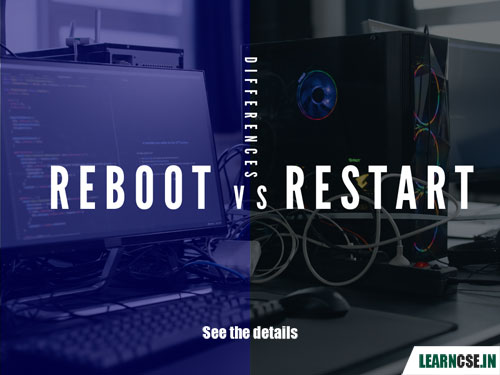In today’s world, smartphones and other electronic gadgets have become an integral part of our daily lives, serving various purposes. People of all age groups, from kids to seniors, rely on smartphones and laptops. However, many users may not have a complete understanding of all the features these devices offer. Some are aware of these features, yet they might hesitate to use them, or they may not fully grasp which feature serves what purpose. Among these features, two essential ones are “reboot” and “restart.”

A lot of individuals use features like “reboot” and “restart” on their devices, but they often do so without a clear understanding of the distinctions between these two functions or what they actually accomplish. If you find yourself in a similar situation, unsure about the differences between rebooting and restarting, don’t fret. Today, we’re here to clarify the difference between reboot and restart for you.
Computer Beeps 3 Times and Refuses to Power Up Problem Fixed
What is the meaning of Reboot?
A “boot” is like waking up a device from a deep sleep, getting it ready to work. When you “boot” a device, you’re turning it on and making all its parts start working. This is often done to start the device from scratch or to fix problems, like when your phone gets stuck or stops responding to apps. It’s a way to give your device a fresh, functioning start. In simple language, a “reboot” means to turn something off and then back on again. It’s like restarting a computer or a device to make it work properly if it’s having problems or to apply changes you’ve made. It’s a way to refresh things, like giving them a fresh start.
What is the meaning of Restart?
“Restarting” is like a quick power nap for your device. It involves shutting down the device and then immediately turning it back on. People do this for a couple of reasons. One, it’s a simple way to refresh the device and apply any changes they’ve made to its settings. For example, when you update the software or make important adjustments, a restart helps the device fully incorporate those changes. It’s like telling your device, “Hey, take a quick break, then come back and work even better!”
Simple Difference Between Reboot and Restart
In simple terms, a reboot is like a full system reset, while a restart is a quick refresh to address minor issues or apply changes.
FAQs
Is reboot and restart same in android?
In Android, “reboot” and “restart” are often used interchangeably, both referring to the action of shutting down and then powering on the device to refresh its operating system and services.
Does reboot delete everything?
A reboot, by itself, does not delete any data on your device. It is simply the act of restarting the device’s operating system and services.
Does reboot mean restart or shutdown?
In the context of computing and devices, “reboot” typically means a combination of both “restart” and “shutdown.” When you reboot a device or system, it first shuts down (halts the operating system and services), and then it starts up again. So, in a sense, a reboot involves both a restart and a temporary shutdown in the process to refresh the system.
Is reboot faster or restart for same device?
For the same device, a “reboot” and a “restart” are essentially the same process, and there is usually no significant difference in the time it takes to perform them. Both actions involve turning off the device and then turning it back on, which generally takes a similar amount of time. The speed of a reboot or restart for the same device would typically be very close, if not identical, as they achieve the same result.

